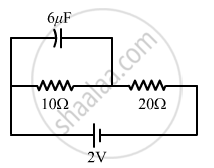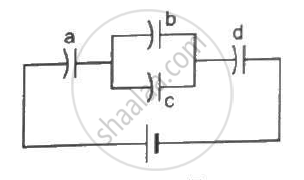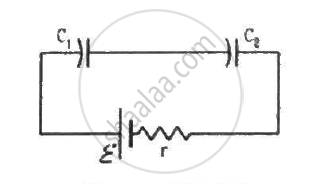Advertisements
Advertisements
Question
A capacitor of capacitance C is given a charge Q. At t = 0, it is connected to an uncharged capacitor of equal capacitance through a resistance R. Find the charge on the second capacitor as a function of time.
Solution
Given:-
Initial charge on first capacitor = Q
Let q be the charge on the second capacitor after time t.
According to the principle of conservation of charge, charge on the first capacitor after time t = Q - q.
Let V1 be the potential difference across the first capacitor and V2 be the potential difference across the second capacitor after time t. Then,
\[V_1 = \frac{Q - q}{C} \]
\[ V_2 = \frac{q}{C}\]
\[ \Rightarrow V_1 - V_2 = \frac{Q - q}{C} - \frac{q}{C}\]
\[ = \frac{Q - 2q}{C}\]
The current through the circuit after time t,
\[i = \frac{V_1 - V_2}{R} = \frac{dq}{dt}\]
\[ \Rightarrow \frac{Q - 2q}{CR} = \frac{dq}{dt}\]
\[ \Rightarrow \frac{dq}{Q - 2q} = \frac{1}{RC}dt\]
\[ \Rightarrow \frac{dq}{Q - 2q} = \frac{1}{RC}dt\]
Integrating both sides within the limits time =0 to t and charge on the second capacitor varying from q=0 to q, we get:-
\[\frac{1}{2} \left[ \ln \left( Q - 2q \right) - \ln Q \right] = \frac{- 1t}{RC}\]
\[\ln \frac{Q - 2q}{Q} = \frac{- 2t}{RC}\]
\[Q - 2q = Q e^{- \frac{2t}{RC}} \]
\[2q = Q\left( 1 - e^{- \frac{2t}{RC}} \right)\]
\[q = \frac{Q}{2}\left\{ 1 - e^{- \frac{2t}{RC}} \right\}\]
APPEARS IN
RELATED QUESTIONS
A 12 pF capacitor is connected to a 50 V battery. How much electrostatic energy is stored in the capacitor?
Find the charge on the capacitor as shown in the circuit.

A 20 μF capacitor is joined to a battery of emf 6.0 V through a resistance of 100 Ω. Find the charge on the capacitor 2.0 ms after the connections are made.
A 100 μF capacitor is joined to a 24 V battery through a 1.0 MΩ resistor. Plot qualitative graphs (a) between current and time for the first 10 minutes and (b) between charge and time for the same period.
How many time constants will elapse before the charge on a capacitors falls to 0.1% of its maximum value in a discharging RC circuit?
Each capacitor in figure has a capacitance of 10 µF. The emf of the battery is 100 V. Find the energy stored in each of the four capacitors.

A capacitor with stored energy 4⋅0 J is connected with an identical capacitor with no electric field in between. Find the total energy stored in the two capacitors.
A capacitor of capacitance 100 μF is connected across a battery of emf 6 V through a resistance of 20 kΩ for 4 s. The battery is then replaced by a thick wire. What will be the charge on the capacitor 4 s after the battery is disconnected?
Consider the situation shown in figure. The switch is closed at t = 0 when the capacitors are uncharged. Find the charge on the capacitor C1 as a function of time t.

A point charge Q is placed at the origin. Find the electrostatic energy stored outside the sphere of radius R centred at the origin.
Choose the correct option:
Energy stored in a capacitor and dissipated during charging a capacitor bear a ratio.
A capacitor is a device that stores ____________.
A parallel plate condenser is immersed in an oil of dielectric constant 2. The field between the plates is ______.
A parallel plate capacitor has a uniform electric field `overset(->)("E")` in the space between the plates. If the distance between the plates is ‘d’ and the area of each plate is ‘A’, the energy stored in the capacitor is ______
(ε0 = permittivity of free space)
A fully charged capacitor C with initial charge q0 is connected to a coil of self-inductance L at t = 0. The time at which the energy is stored equally between the electric and magnetic fields is ______.
A parallel plate capacitor (A) of capacitance C is charged by a battery to voltage V. The battery is disconnected and an uncharged capacitor (B) of capacitance 2C is connected across A. Find the ratio of total electrostatic energy stored in A and B finally and that stored in A initially.
In a capacitor of capacitance 20 µF, the distance between the plates is 2 mm. If a dielectric slab of width 1 mm and dielectric constant 2 is inserted between the plates, what is the new capacitance?
